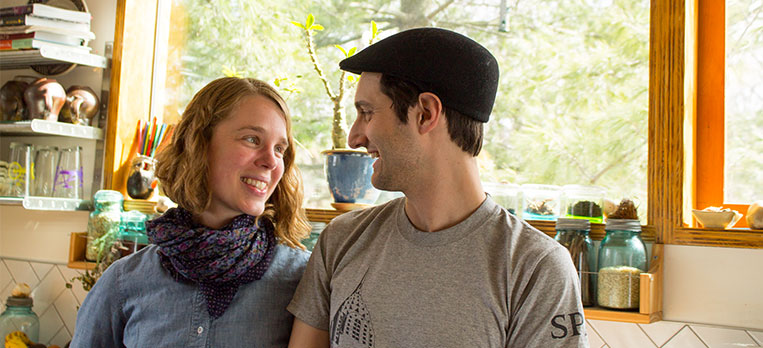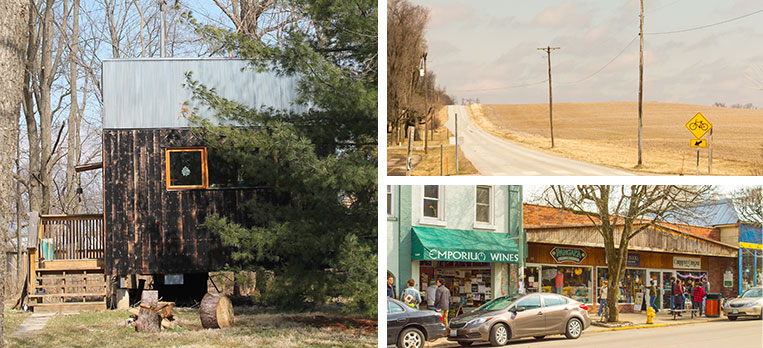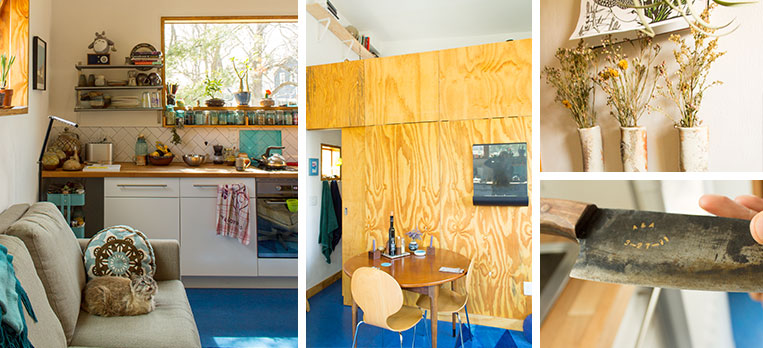
Is it the size of your house that matters, or the community it makes you a part of? Communities give us places to work and play, they are the friends and family who give us purpose and support. We might think of home as what’s contained within our walls, but what’s outside of them can be just as important.
Alex and Allison weren’t concerned with the size of their house, but they wanted their home to provide easy access to the people and activities that make their lives feel full and meaningful. A tiny home was just the path that got them there. They bought a nearly vacant lot in the colorful, small town of Yellow Springs, Ohio and applied to build a main house and a fully legal, 320 foot, accessory dwelling. Once approved, they simply built the “accessory” first, and have lived there for over a year and a half.
They see many ways that small housing and community support each other, both through Allison’s experiences with communal living, and Alex’s take on how small housing can help keep small towns alive. These are abridged and edited highlights of my fun visit with Alex and Allison, but there’s much more in my ebook, Life in a Tiny House.
What Do You Need In Your House, and What Do You Need Outside?
Building a cool, modern tiny home in an Ohio town of 3,500 people puzzled me at first, but made sense once I visited. The compact main street was packed with cafes, cute restaurants, and other hallmarks of thriving urban areas. This truly livable community is a big part of what brought Alex and Allison to Yellow Springs – their house location has a “Walk Score” nearing 90 of 100, and gives them easy access to their communities of friends, work, and resources they value.

Allison: We’re really connected with nature, even though we’re in a town. The nature preserve is a five minute walk down the bike path. Often on a really nice day we’ll get up, go to the farmer’s market, go for a hike later in the day, and have people come over and spend time in our space.
Alex: I get to take a short bike ride to the office and come home for lunch by the same method. It’s so freeing. Like a lot of younger people today, I don’t really want to drive a car every day.
Allison: I used to commute 45 minutes each way to my job when we lived in Denver. Now when I go teach at the elementary school, it’s two blocks. It’s great. My best friend, she’s a five to ten minute walk away. Most of it is accessible, all the things we want to do.
Alex: I’d rather buy new shoes than brake pads. [Laughs] A few months from now, we’ll be able to go right outside our door and harvest some vegetables, and cook in good company, and maybe go for a beer after dinner. And it’s not like we have to pick a day when we’re going to clean, either. It takes about 20 minutes.
How Small Housing Can Strengthen a Community
As an architectural designer, Alex’s passion for small and sustainable spaces led him to design and build an accessory home they’d be happy to live in while preparing to build the main house – a whopping 800 square feet. An accessory dwelling is basically a little living space that shares a lot with a “big house,” but is functionally independent. Main house owners might build them to host aging family members, or rent out for extra income.

Once the main home is complete, Alex and Allison can use the little house as an office, guest house, or affordable rental property in the challenging local rental market. This is another community benefit of accessory dwellings: more housing density, or “infill,” can help distribute the town’s rising property taxes and maintain valued community services like well-regarded schools.
Alex: If we can get more infill, then we can have more density and grow this town in the only we that we can. We’ve all, as a community, said we don’t want to sprawl. The only way to do it after that is up, or infill. And there’s a big problem with property taxes being too high. We’ve got great schools, but a lot of people are being priced out. The more people that can live here, the lower our individual property taxes are. So there’s a larger goal there: to continue being a living community, not a bedroom community, and not a hollow shell of a town.
What Are Your Housing Needs Today? Tomorrow? In Ten Years?
Having tried out different communal living situations like cohousing and intentional communities, Allison recognizes that her little house satisfies her need for private life and community connection, but also that needs change over time.
Allison: I really value community, but I’m a fairly private person. I like to have down time that is solitary. Our space doesn’t have to be huge for that, but I need to have a nook that I can call my own, and then I can go back out and be energized in the community.
Some of my best experiences have been living in shared spaces. It was really important to who I am as a person, I think there’s just a place and time for it. It’s not something you have to commit your whole life to.
We may live in a tiny house for two years, five years, ten years, and then we’ll live in a different type of home. And then maybe we’ll do some cohousing again. I think that’s a concept generationally that people are becoming more comfortable with – we’re not necessarily going to buy one house and live in it for 50 years.
Learn more about Alex and Allison’s little house at Green Generation Building, or follow along with their building process on their blog.

Comments are closed.